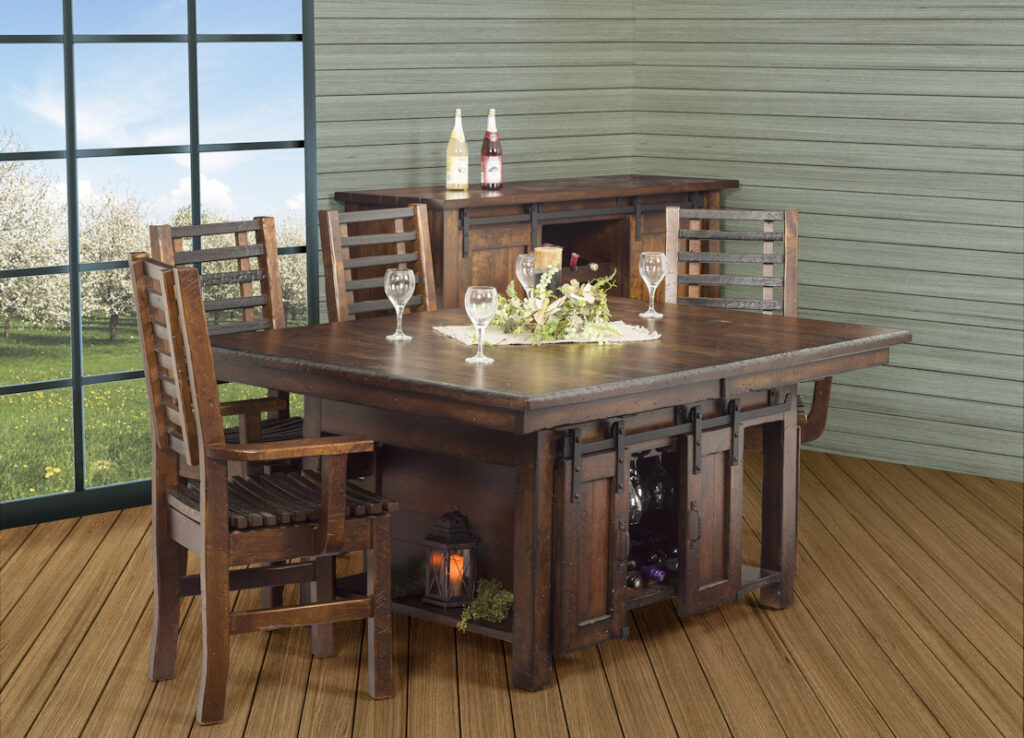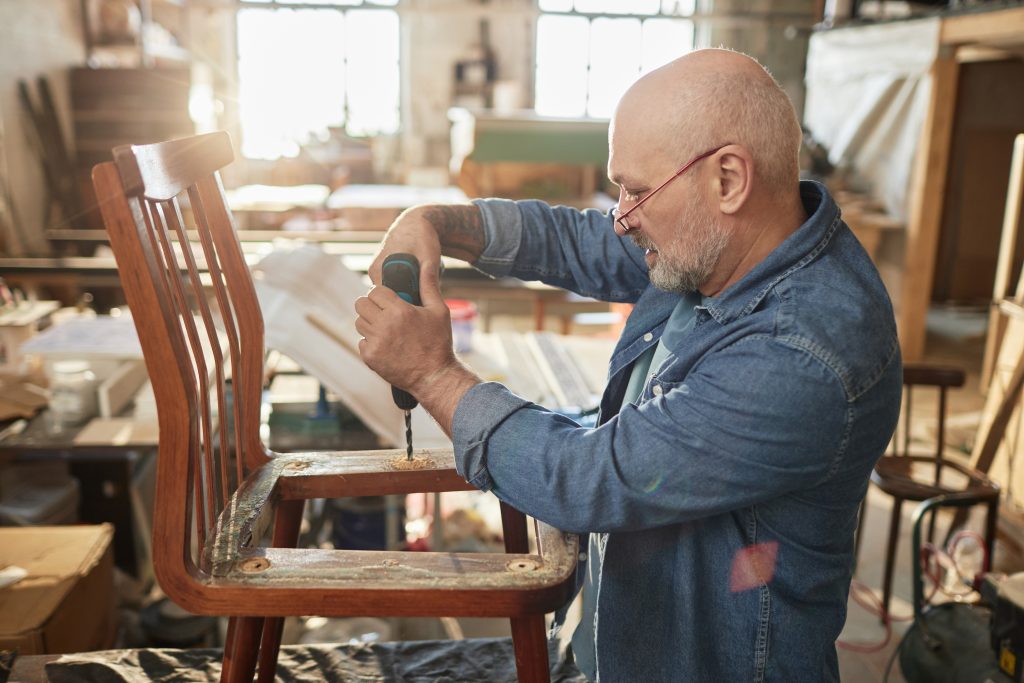
Dining Room Tables
Amish dining room tables are renowned for their exquisite craftsmanship, exceptional quality, and timeless designs. Handcrafted by skilled artisans, these tables showcase the beauty of solid wood, attention to detail, and a commitment to traditional woodworking practices. In this comprehensive blog post, we will explore the unique features and benefits of owning an Amish dining room table, including their craftsmanship, design elements, customizability, durability, maintenance requirements, and the significance of supporting Amish artisans. Let’s embark on a journey to discover the captivating world of Amish dining room table craftsmanship.
What sets Amish dining room tables apart in terms of craftsmanship and quality?
Amish craftsmen are known for their unwavering commitment to traditional woodworking techniques, passed down through generations. With meticulous attention to detail, these skilled artisans handcraft each dining room table, ensuring impeccable quality, superior craftsmanship, and exceptional durability.

What are the key characteristics and design elements commonly found in Amish dining room tables?

Amish dining room tables exhibit several key characteristics and design elements, such as:
- Solid Wood Construction: Amish tables are crafted from high-quality solid wood, renowned for its strength, natural beauty, and longevity.
- Simple and Timeless Designs: Amish dining room tables often feature clean lines, minimalistic designs, and timeless aesthetics that effortlessly blend with various interior styles.
- Handcrafted Joinery: Amish craftsmen employ traditional joinery techniques ensuring the structural integrity and longevity of the table.
These characteristics of Amish dining room tables obviously show the value and desirability of a beautiful dining room, but did you know that these tables can be custom designed to meet your needs?
Can Amish craftsmen create custom dining room tables to meet specific size or style requirements?
Absolutely! Amish craftsmen understand that every home is unique, and they excel at creating custom dining room tables tailored to individual size, style, and design preferences. Whether you require a specific length, width, or a distinct design element, Amish artisans can bring your vision to life. Custom Amish dining room tables also allow you to make something unique for you and your family and friends that you can gather around without being limited by standard sizing of tables.

How does the use of solid wood contribute to the durability and longevity of Amish dining room tables?

Solid wood is a preferred choice for Amish dining room tables due to its inherent strength, durability, and ability to withstand the test of time. Solid wood dining room tables by the Amish can endure daily use, resist warping or cracking, and retain its beauty for generations. The durability of Amish dining room tables allows for your table to not only be a centerpiece for your house, but a lasting heirloom.
Are there specific traditional or popular styles of Amish dining room tables available?
Amish dining room tables encompass a wide range of traditional Amish dining room table designs and popular styles, including:
- Shaker Style: Known for its simplicity and functionality, Shaker-style tables feature clean lines and understated elegance.
- Mission Style: Influenced by the Arts and Crafts movement, Mission-style tables showcase sturdy construction, straight lines, and often include decorative details like slats or inlays.
- Farmhouse Style: Embracing rustic charm, farmhouse-style tables evoke a warm and welcoming atmosphere with their robust construction, distressed finishes, and turned legs country-inspired designs.
While these are a few of the different Amish dining room table styles, the options are as varied as the homes they are in.

How are Amish dining room tables handcrafted, and what techniques do the craftsmen employ?

Handcrafted dining room tables from the Amish are meticulously designed and built using time-honored techniques. Skilled craftsmen employ traditional tools and woodworking methods, including hand planing, carving, and sanding, to shape the wood, create intricate details, and achieve a smooth, flawless finish. The artisans’ expertise and dedication to their craft ensure that each table is a masterpiece.
Traditional Woodworking Tools:
Amish craftsmen rely on traditional woodworking tools to shape and manipulate the wood. Tools such as hand planes, chisels, saws, and mallets are meticulously wielded, allowing the artisans to create intricate details and refine the table’s structure.


Selecting the Finest Wood:
Amish craftsmen carefully choose the finest quality hardwood for their dining room tables. Common wood species used include oak, cherry, maple, walnut, and hickory. Each wood species possesses unique characteristics, such as grain patterns, color variations, and natural durability, which contribute to the table’s overall aesthetics and longevity. Other types of wood that is offered includes rustic quarter sawn white oak, rustic hickory, rustic cherry, elm and more.
Hand Planing:
Hand planing is a crucial step in the process of creating an Amish dining room table. Skilled craftsmen use hand planes to smooth and level the surfaces of the wood, ensuring a flawless finish and removing any imperfections or irregularities. A different look is now offered with hand panning along with rough-sawn, hand worn edges, distressing (which gives a more rustic look), knot holes and other imperfections, which all contribute to a rustic look.


Joinery Techniques:
Amish craftsmen employ traditional joinery techniques to ensure the structural integrity and longevity of the dining room table. Techniques such as mortise and tenon joints, dovetail joints, and tongue and groove joints are meticulously crafted by hand. These techniques create strong, durable connections between the table’s components, ensuring stability and longevity.
Carving and Detailing:
Amish dining room tables can feature intricate carvings and detailing that showcase the artisan’s skill and attention to detail, but much of this is usually found in the fee of the tables. These embellishments can include decorative patterns, engraved designs, inlay in tabletops, or carefully crafted edges and corners. Hand-carving adds a touch of artistry and personalization to the table, making each piece unique.


Sanding and Smoothing:
After the joinery and carving are complete, the table undergoes a thorough sanding process. Amish craftsmen use various grits of sandpaper to achieve a smooth and flawless surface. This step is crucial in creating a table that is both aesthetically pleasing and comfortable to the touch.
Finishing Touches:
The final step in crafting an Amish dining room table is the application of finishes. Amish craftsmen may use a variety of finishes, including oils, stains, lacquers, or wax, to protect the wood, enhance its natural beauty, and create a long-lasting surface. The choice of finish depends on the desired look and the type of wood being used. The types of finish may include the choice of sheen, from flat matte to glossy. While some finishes are resistant to moisture, they are not resistant to heat or scratches.

What are the advantages of owning an Amish dining room table compared to mass-produced alternatives?

Choosing an Amish dining room table offers several advantages over mass-produced alternatives:
Superior Quality: Amish tables are crafted with exceptional attention to detail, ensuring superior quality and longevity.
Customization Options: Amish craftsmen can customize tables to fit your unique requirements, allowing you to create a one-of-a-kind centerpiece for your dining space.
Ethical and Sustainable: By supporting Amish artisans, you contribute to the preservation of traditional woodworking practices and sustainable craftsmanship.
What features should one look for when selecting an Amish-built dining room table?
When selecting an Amish-built dining room table, consider factors such as the quality of wood, joinery techniques, finish options, and the overall design that complements your style and space. Ensure that the table meets your size requirements and provides adequate seating for your family and guests.

Do Amish dining room tables require any special care or maintenance?

An Amish dining room table is not just a functional piece of furniture but also a timeless work of art. Crafted with exceptional skill and using the finest quality wood, it deserves proper care and attention to ensure its longevity and beauty for generations to come. With the quality of materials and craftsmanship, Amish dining room tables are designed to withstand everyday use and require minimal maintenance. Here’s a few tips below:
Regular Cleaning:
Regular cleaning is crucial to prevent dirt, dust, and debris from accumulating on the surface of your dining room table. Start by removing any loose particles with a soft, dry cloth. Then, dampen a clean cloth with mild soapy water and gently wipe the surface, following the grain of the wood. Avoid using abrasive cleaners or harsh chemicals that can damage the finish. It is important to maintain the table, not only by cleaning, but to keep the wood from drying out. Lemon oil or orange oil is great for cleaning and treating the table, protecting it from drying out, cracking, or warping.


Avoid Direct Sunlight and Heat:
Amish dining room tables should be placed away from direct sunlight or heat sources. Prolonged exposure to sunlight can cause the wood to fade and become discolored. Similarly, extreme temperature changes can lead to warping or cracking of the wood. Consider using curtains or blinds to protect your table from direct sunlight and maintain a stable temperature in the room.
Use Coasters, Placemats, and Trivets:
To protect the surface of your Amish dining room table from spills, heat, and scratches, always use coasters for glasses, placemats for plates and cutlery, and trivets for hot dishes or serving pots. These simple precautions will prevent unsightly stains, marks, or heat damage, keeping your table in pristine condition.


Avoid Excessive Moisture:
Wood is susceptible to damage from excessive moisture. Wipe up any spills immediately to prevent moisture from penetrating the wood and causing swelling or warping. Use a dry cloth to absorb the liquid and then follow up with a slightly damp cloth to clean the area. Dry the surface thoroughly afterward. Even if the finish is resistant to moisture, prolonged exposure to moisture may damage the table.
Maintain Consistent Humidity Levels:
Wood expands and contracts with changes in humidity. It is important to maintain consistent humidity levels in the room where your Amish dining room table is located. Use a humidifier during dry seasons to prevent the wood from drying out and a dehumidifier in humid climates to reduce moisture levels. This helps prevent issues such as warping or cracking. In some homes that have very dry heat, a humidifier is helpful.


Polishing and Waxing:
Periodically, your Amish dining room table will benefit from polishing and waxing to restore its natural luster and protect the wood. Use a high-quality furniture polish or wax specifically designed for wood furniture. Apply it with a soft cloth, following the instructions on the product. Regular polishing will help maintain the table’s beauty and provide an additional layer of protection. Mary Jane’s recommends regularly dusting with an oil (lemon or orange, etc.) to keep clean and from drying out.
Professional Restoration and Repair:
If your Amish dining room table sustains significant damage or wear over time, consider consulting a professional furniture restorer or repair specialist who specializes in working with wood. They can address issues such as scratches, dents, or refinishing needs, ensuring that your table retains its original beauty.

How does the purchase of an Amish dining room table support local craftsmanship and traditional woodworking practices?

In a world dominated by mass-produced furniture, the purchase of an Amish dining room table holds special significance. By investing in an Amish-made piece, you not only acquire a beautifully crafted and durable table but also contribute to the preservation of Amish craftsmanship and traditional woodworking practices.
- Upholding Craftsmanship Traditions:
Amish communities have a deep-rooted tradition of craftsmanship that has been passed down through generations. By purchasing an Amish dining room table, you actively support these traditions, ensuring that the skills and knowledge of traditional woodworking techniques are preserved. The Amish take immense pride in their craftsmanship, and each table is meticulously handcrafted with attention to detail and a commitment to quality.


- Sustaining Local Economies:
Amish communities are typically located in rural areas where traditional occupations, such as farming and woodworking, play a vital role in the local economy. By purchasing an Amish dining room table, you directly contribute to the economic well-being of these communities. The income generated from the sale of handmade furniture helps support the livelihoods of Amish craftsmen and their families, enabling them to continue practicing their traditional trade.
- Promoting Sustainable Practices:
Amish woodworking emphasizes sustainable practices and the use of natural materials. The tables are typically constructed from solid wood sourced from responsibly managed forests. Unlike mass-produced furniture that often incorporates composite materials or veneers, Amish dining room tables use high-quality, solid wood that is known for its durability and longevity. By choosing an Amish table, you support sustainable practices that prioritize the use of renewable resources.


- Preserving Artistic Integrity:
Amish furniture is renowned for its timeless beauty and exquisite craftsmanship. Each table is a unique piece of art, showcasing the skills and creativity of the individual craftsman. The purchase of an Amish dining room table ensures that these artistic traditions thrive. Unlike mass-produced furniture that often lacks character and individuality, an Amish table carries the distinctive mark of the artisan who carefully shaped and finished it.
Amish dining room tables are true masterpieces, handcrafted with meticulous attention to detail and a deep understanding of traditional woodworking techniques. The features of Amish-built dining room tables embody the essence of exceptional craftsmanship, timeless design, and enduring quality. With their dedication to traditional woodworking techniques, use of solid wood, and ability to create custom pieces, Amish craftsmen produce dining room tables that become cherished heirlooms. By owning an Amish dining room table, you not only acquire a beautiful and functional piece of furniture but also become a patron of local craftsmanship and an advocate for the preservation of traditional woodworking practices. At Mary Jane’s Oak Furniture, you can choose an Amish dining room table to elevate your dining experience and create a lasting legacy in your home.

